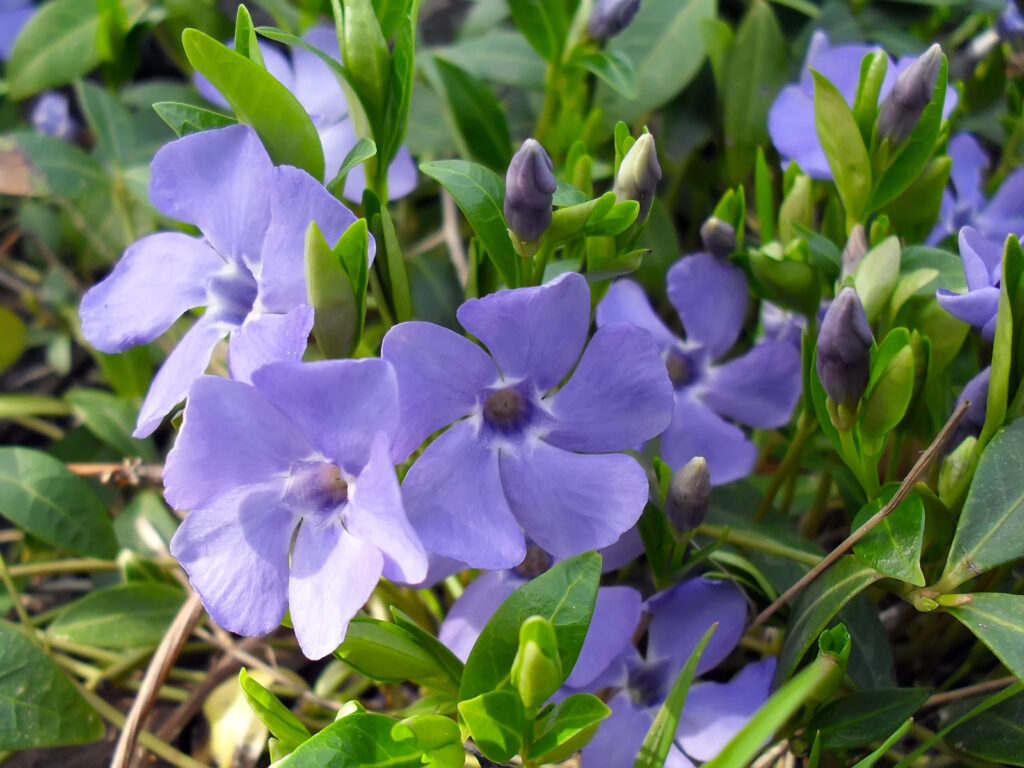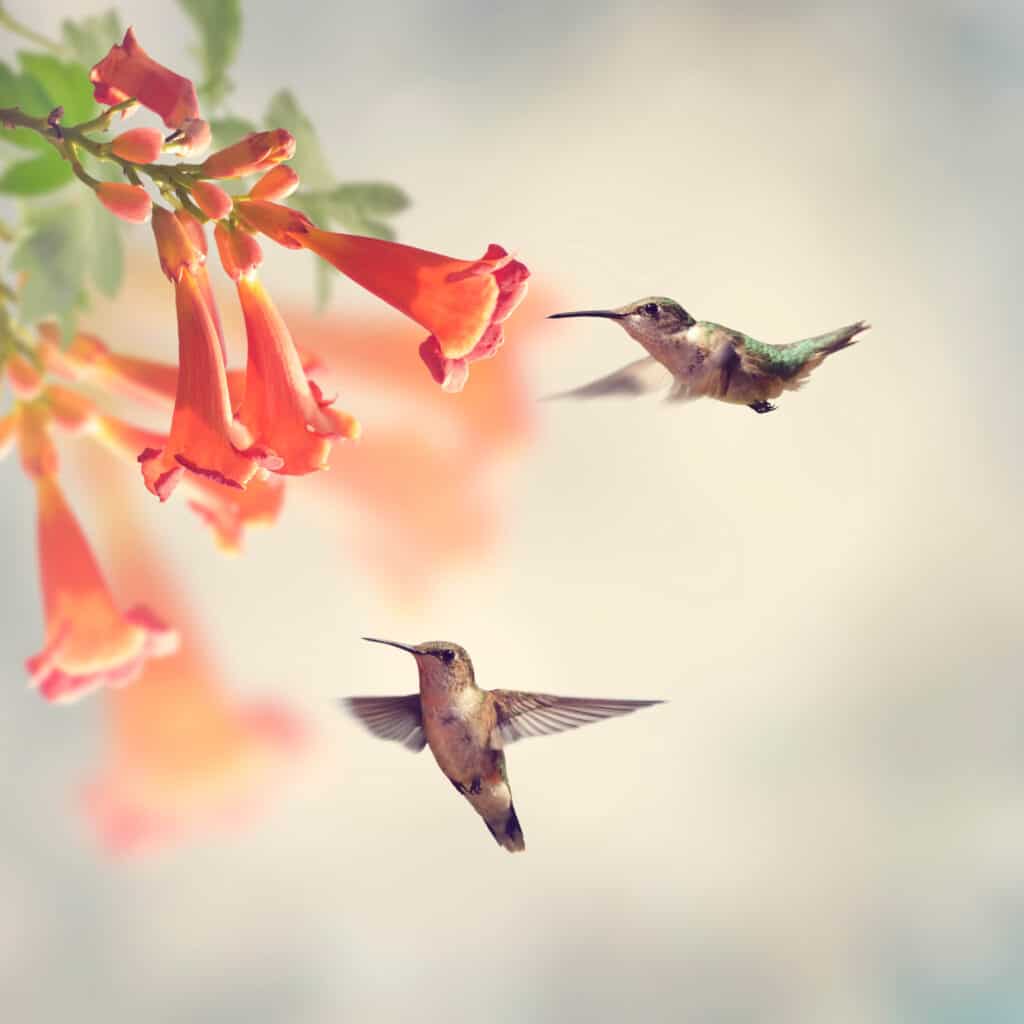Nature’s Strategies
While plants do not sit around thinking of strategies for pollination, and hummingbirds do not fly around looking for flowers to pollinate—the fact is, hummingbirds visiting flowers is indeed a strategy—a natural strategy—to aid reproduction.
For plants to develop fertile seeds to produce more plants, the flower must be pollinated. By producing nectar, certain flowers attract hummingbirds (and bees), that—while feeding on the nectar—collect pollen on their feet or feathers. The birds and insects carry the pollen to other flowers where it falls off and fertilizes future seeds.
A trumpet-shaped flower, with nectar, is one of Nature’s strategies to ensure fertile plant seeds for the future.
The Hummingbird Vine

The trumpet vine, Campsis radicans, is also known as the hummingbird vine or trumpet creeper. It is a perennial deciduous woody vine native to North America that is also found in scattered locations in both Europe and South America. Typically, it grows up to 30 feet high, climbing the trunks of trees, power poles, and other supporting structures. It is common in woodlands, especially along woodland edges or creeks and streams where sunlight reaches the ground. It is easily recognized by its showy, typically red-orange trumpet-shaped flowers.
It is also found in gardens, but, if not pruned seasonally, this fast-growing vine can become an invasive plant, taking over other trees and structures within its reach. Additionally, their roots may fan out under ground and send up suckers that may have to be cut or mowed.
While the flowers attract hummingbirds, the dense foliage provides nesting sites for other species of smaller birds.
Is Trumpet Vine Poisonous?
The trumpet vine is not poisonous like poison ivy, but it can cause redness and itching on the skin of some people following contact with the leaves. Also, note that the plant has a high flammability rating and should not be planted next to homes and other, especially wooden, structures.
Varieties
There are several cultivars of the trumpet vine with names such as “apricot,” “crimson trumpet,” or “Indian summer” that have flowers of different shades of crimson to orange-yellow.
They all bloom from mid-summer to early fall, providing hummingbirds with a consistent source of nectar.
Containers
Hummingbird vines can be grown in containers. A large container is needed—e.g., a planter the size of a barrel cut in half. Also, this is a vine and it will need something sturdy to climb like a large trellis. It will also have to be pruned regularly to prevent it from spreading to nearby bushes, tree, or structures. You can learn more about growing these vines in containers at https://www.gardeningknowhow.com/ornamental/vines/trumpet-vine/trumpet-vines-in-containers.htm.
Other Vines Hummingbirds Love
Although the trumpet vine is a member of a very large family of plants, many vine-like plants with trumpet-shaped flowers are not in the trumpet flower family. Examples include honeysuckle (Genus Lonicera), Mandevilla (Genus Mandevilla), candy corn plant (Genus Cuphea), and hyacinth bean (Genus Dolichos), to mention a few.
Cypress Vine

A popular alternate to the trumpet vine is the Cypress Vine (Ipomoea). Like many such plants, it is called by many names including cypress vine morning glory, cardinal creeper, cardinal vine, star glory, or even hummingbird vine. While it is a tropical plant, it can be grown as an annual in the spring and summer across much of the United States. It is an excellent alternative to the “trumpet vine” described above, especially if you do not want to manage an invasive plant. The cypress plant must be planted each year. Cypress vines are easily grown from seeds that may be found in garden shops or from online vendors.
Morning Glories

The genus Ipomoea also includes morning glories, an easy-to-grow plant with pink, blue, or white trumpet shaped flowers. Native or escaped morning glories are often seen growing along fences in rural areas. To grow morning glories in your yard, use a piece of fence wire between two posts, or simply set up a ring of fencing three or four feet in diameter, and plant seeds along the base of the fence wire.
Vinca

Vinca (Vinca) is an easy-to-grow, manageable perennial, ground-hugging vine with a flower that attracts hummingbirds. It can be grown in planters along the sunny edge of a porch or in flower beds around the yard. This flower rarely grows taller than 12 inches with profuse violet-to-pink and white blossoms. A bed of these will become a magnet for hummingbirds. Vinca are somewhat invasive. If left untended, they will gradually grow beyond the boundaries of their flower beds. But they are easily controlled by mowing, cutting, or digging up the plants that grow beyond their intended boundaries. Vinca are commonly available in garden shops that offer live plants. Once established, small plants grow rapidly. They die back during the winter but will return in early summer.
Mandevilla

In warmer climates (zones 10 and 11), Mandevilla vines on a trellis near an outdoor seating area are not only colorful but can become a “hive” of activity for hummingbirds. These drought-tolerant vines can be grown in containers, hanging baskets, or in the garden. The mandevilla does equally well in full sun to part shade and prefers a well-drained soil. There are many cultivars with a variety of colors to suit both your style and to attract hummingbirds.
Hyacinth Bean

The hyacinth bean plant (Dolichos) is a vigorous ornamental annual vine. In bloom, the vine is heavily laden with hummingbird-loving pinkish-purple blossoms that produce reddish-purple bean pods. Collect the pods at the end of each season to plant the following year. The beans are easy to grow—all that is needed is average soil and a sturdy trellis or support to climb on—they will easily grow to 10 or 15 feet high. They do best in full sun. As with any of these plants, select a location that will encourage the growth of the plant, and a location where you can enjoy the hummingbird activity.
Hummingbird Feeders Versus Flowers
All of the plants described above are both attractive and hummingbird favorites. However, if you also have active hummingbird feeders around your yard, hummingbirds will go to the best source of “nectar.” That means if you want to watch the hummingbirds visit the blooms you have set out for them, set aside the feeders while the gardens are in blossom. Put feeders out early in the spring to encourage the “hummers” to hang around your yard. As the flowers begin to bloom, gradually reduce their access to feeders. Then, as the flowers begin to fade, re-establish the feeders.
References
_______
4Top 10 Vines for Hummingbirds
4 Ibid

